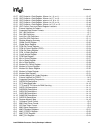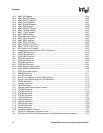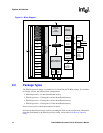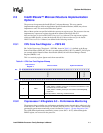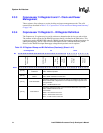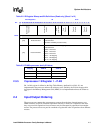
Intel® PXA26x Processor Family Developer’s Manual 1-5
Introduction
The STUART’s transmit and receive pins are multiplexed with the fast infrared communication
port.
1.2.14 Real-Time Clock (RTC)
The RTC can be clocked from either the 3.6864-MHz crystal or from an optional 32-KHz crystal.
A system with a 32.768-KHz crystal consumes less power during sleep versus a system using only
the 3.6864-MHz crystal. The RTC provides a constant frequency output with a programmable
alarm register. This alarm register can be used to wake up the processor from sleep mode.
1.2.15 Operating System (OS) Timers
The OS timers can be used to provide a 3.68-MHz reference counter with four match registers.
When equal to the reference counter, the four match registers can be configured to cause interrupts.
One match register can be used to cause a watchdog reset.
1.2.16 Pulse-Width Modulator (PWM)
The PWM has two independent outputs that can be programmed to drive two GPIOs. The
frequency and duty cycle are independently programmable. For example, one GPIO can control
LCD contrast and the other LCD brightness.
1.2.17 Interrupt Controller
The interrupt controller directs the processor interrupts into the core’s interrupt request (IRQ) and
fast interrupt request (FIQ) inputs. The Mask Register enables or disables individual interrupt
sources.
1.2.18 Integrated Synchronous Flash
The synchronous flash integrated into some versions of the PXA26x processor family is based on
the synchronous Intel StrataFlash® memory (K3). 128 Mbit or 256 Mbit of flash in a x16
configuration, and 256 Mbit of flash in a x32 configuration are available. This flash supports bus
frequencies as fast as 66 MHz. This flash uses one chip-select, nCS0.
1.2.19 Single-ended Universal Serial Bus Client interface
On the Intel® PXA26x Processor Family, a single-ended interface to an external transceiver was
added which can be used instead of the differential interface.
The extra pins required are multiplexed on the AC97 second codec interface, MMC second card
chip select, and the FFUART. Multiplexing these pins with the FFUART lets you easily switch
between a USB interface or UART interface for a cradle.



